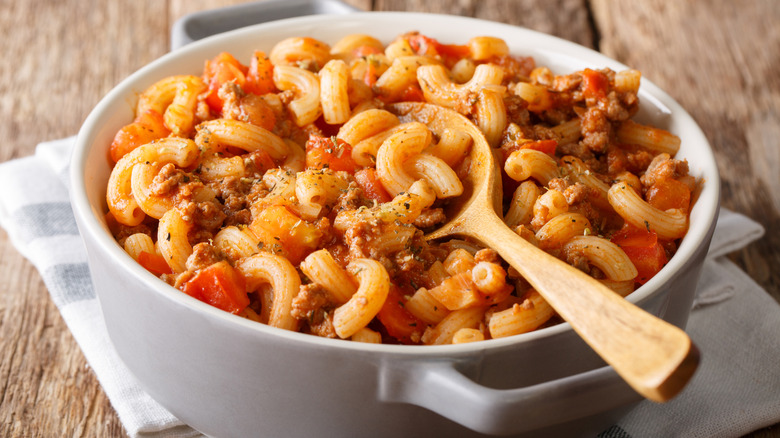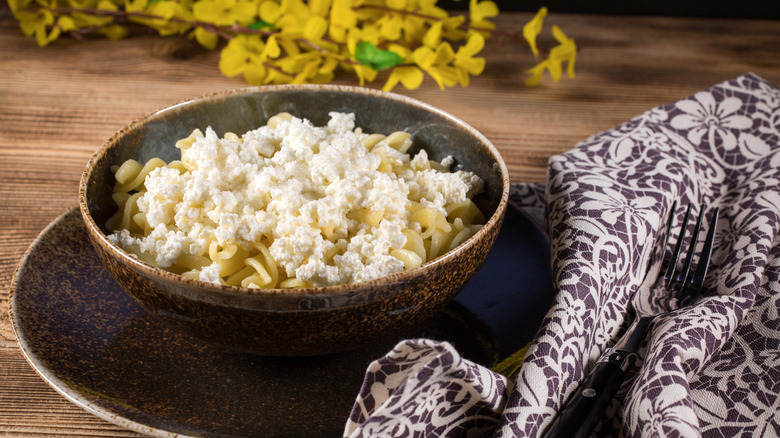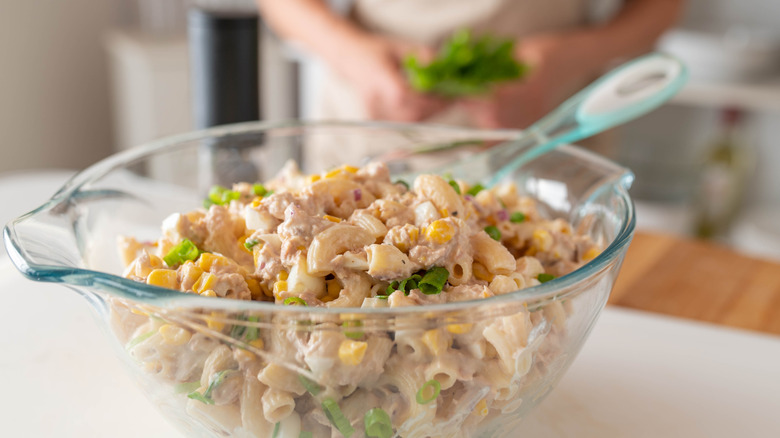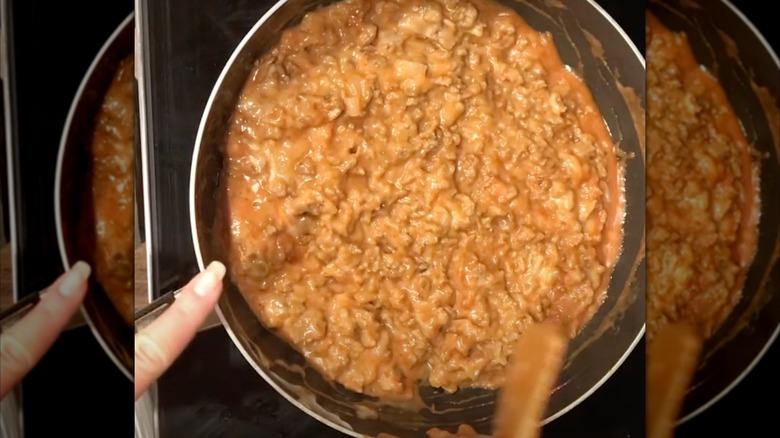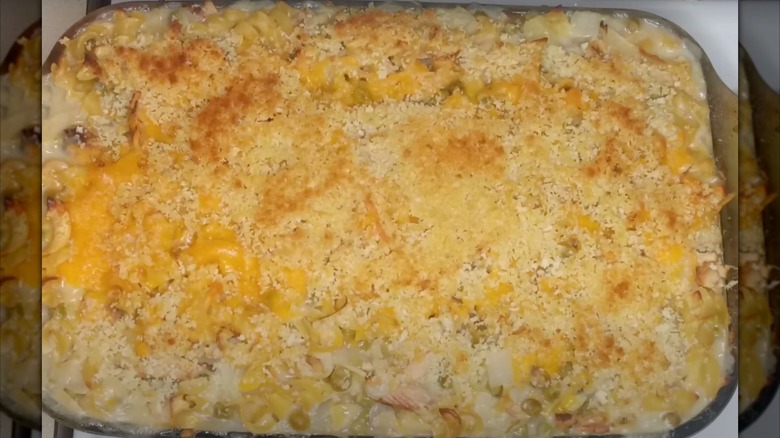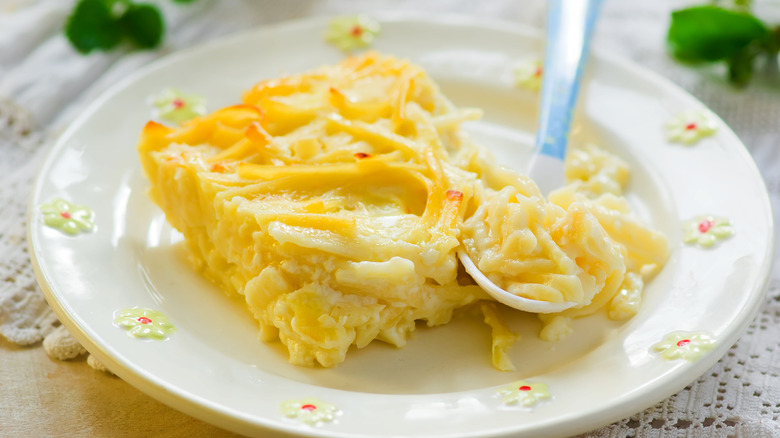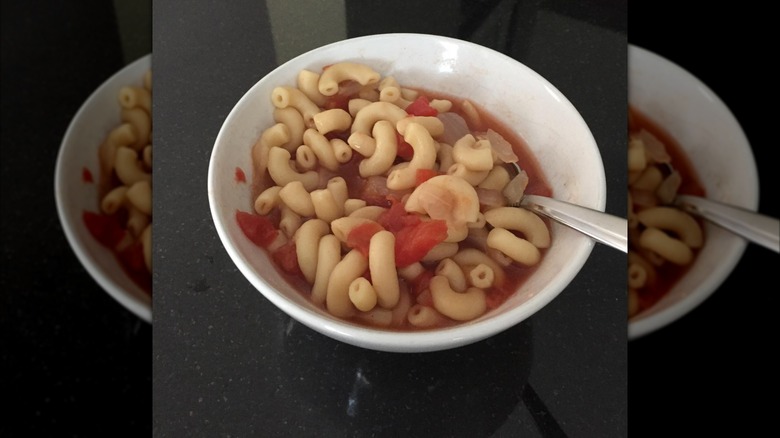Retro Pasta Dishes You Rarely See On Dinner Tables Anymore
There are a lot of classic pasta dishes out there. Most of us have had plenty of bowls of cacio e pepe and spaghetti carbonara in our time, and reveled in flavors that have been pleasing people for decades, if not centuries. However, there's a difference between classic pastas and retro ones — you know, the kind that appeared on recipe cards in mid-century America and left a generation of people utterly baffled at the audacity of some of their offerings. Like many foodstuffs in the 20th century, pasta was subject to a lot of experimentation, in a way that would leave many Italians shocked and modern tastebuds offended.
As such, it's little wonder that many of these retro pasta dishes died off a long time ago, and are rarely (if ever) seen on dinner tables today. However, it's worth reaching back, if not just to see exactly how heinous some of these recipes really were. Dishes like salmon macaroni casserole and tenderoni and liverwurst weren't just fever dreams, but genuine weeknight dinners. In other cases, some retro pasta dishes were far from bad, but now bear a whiff of staleness that's kept them in the past.
Johnny Marzetti
If you grew up in the Midwest, you (or your parents) may have had a few Johnny Marzettis back in the day — but we'd be surprised if you found it anywhere now. Perhaps the strangest name for a pasta dish out there, Johnny Marzetti is a baked pasta that's a sort of twist on a classic lasagna, but without the flat sheets. Johnny Marzetti was especially popular as a school lunch in states like Ohio, due to its ability to be cooked in bulk using relatively cheap ingredients, as well as the fact that it's pretty easy to please kids with pasta, ground beef, and cheese. Its appeal lies in its rough and ready nature, but all the other baked pasta casseroles out there have overtaken this classic, and it has now fallen into obscurity.
We know what you're all thinking, though: Why is it called that? Well, as you might have guessed, Johnny Marzetti is named after the person who (allegedly) created it. Joseph Marzetti was a restaurateur who opened an eatery in 1896, located near Ohio State University. The dish was apparently created with hungry students in mind, with the casserole named not after Joseph, but his brother.
Cottage cheese seashell casserole
This is one of those pasta dishes that sounds a lot worse than it probably tastes, but it's ultimately let down by its name. Cottage cheese seashell casserole was a dish promoted by Borden's, a Canadian cottage cheese producer that was trying to plug its product's use back in the 1950s. The recipe for this dish was circulated on advertising materials from the company, and involved combining cottage cheese with a béchamel sauce, mixing the concoction with pasta shells, canned salmon, and frozen peas, and then baking it until browned.
We'd imagine that this dish attempted to capture the cottage cheese craze of the 1950s, when it became a trendy health food and an alternative to regular cheese. We bet that it wasn't too bad, too: Cottage cheese has a lightly sour flavor that would work well in pasta sauces, and the salmon likely added a touch of brininess, as well as some pleasant umami. However, the clunky title for this recipe hardly makes anyone excited to try it, so we're not surprised that it died out.
Sunshine salad
Doesn't this dish have a name that just makes you happy? We think so too — we just wish that it tasted better than it does. Sunshine salad was a retro pasta dish that was used by Pathmark to sell its elbow macaroni, and the recipe came printed on the back of boxes. The dish was a pasta salad that took a "more is more" approach, and threw in virtually every ingredient under the sun.
To make sunshine salad, you took cooked macaroni, mayo, tuna, and celery, and combined them all together. So far, so good. Then, the recipe instructed that folks add green pepper (okay, not bad), pineapple chunks (wait, what?), sweet pickles (no, no, no), and processed American cheese (we're done here). You don't have to be an expert to know that all of those ingredients would create a horrific flavor clash. The fish, sweet pickles, and pineapple would give you an unpleasant balance of sweet, salty, and vinegary, while the cheese would add a layer of artificial creaminess that would get in the way of everything. You know that Coco Chanel quote about taking one thing off before you leave the house? They should have applied that to sunshine salad, and removed a couple extra things for good measure.
Irish-Italian spaghetti
As far as mid-century pasta dishes go, Irish-Italian spaghetti is one of the weirdest. It's also one that has a name which makes no sense. Appearing in "Better Homes & Gardens" in 1940, this spaghetti dish seemed to be a pretty simple ground beef and pasta combination. Where it got a little strange, though, was in the ingredients used to make the sauce. Rather than opting for fresh or canned tomatoes, or light or heavy cream, it instead instructed the cook to add cream of mushrooms and condensed tomato soup. Oh, and you were also supposed to add some Tabasco, chili powder, and parmesan, for good measure.
First things first, we have to beg the question: What's Irish about this dish? Also, what's Italian about it, aside from the spaghetti, the parmesan, and the vague serving style? It feels like a mash-up of two cultures where neither culture is represented properly. We wouldn't mind so much if it actually tasted good, too, but folks who have recreated this recipe in modern times have pointed out how bland it is. The lack of flavor is pretty weird considering how many ingredients are in the mix, and how much salt there is thanks to the soup cans.
Salmon macaroni casserole
We really struggle with this one, guys. The salmon macaroni casserole comes from the age when people were throwing anything in a dish and calling it a meal (also known as the mid-20th century). Although recipes for this dish vary, perhaps the most unsettling one comes from a recipe card printed by Ann Page Foods, which was used as a way to sell boxed macaroni. The company called its version a "s'macaroni bake," and to make it, folks had to combine salmon, elbow macaroni, vegetables, lemon juice, and white sauce. This concoction was then pressed into a precooked pastry shell and baked. Once that was done, home cooks crowned it with strips of red pepper and sliced olives, arranged in a lattice shape.
There's so much going on here that we don't quite know where to begin. Salmon and pasta can go together well, but in baked form it turns into a compacted, dense mess. The olives and red pepper, meanwhile, add an unpleasant brininess and sharpness that just doesn't go with the white sauce at all. Plus, the pastry shell just feels unnecessary. This is definitely a recipe to leave in the past.
Spaghetti-filled peppers
Stuffing vegetables is one of the oldest forms of preparing them, with ancient Greek and Roman civilizations doing so with a range of different produce. The recipes that these ancient chefs perfected, which involved placing meat, a carbohydrate like rice or barley, herbs, and spices into the veggies before cooking them, have barely changed to this day. When stuffed peppers first started being printed in American cookbooks, they felt pretty similar to what had come before, although additions like butter and tomatoes were now more common.
However, once the 1940s rolled around, people started to get brave and began putting virtually anything they could find into their peppers. That included spaghetti. A 1940s recipe printed by Ann Page Foods, for example, stated that folks should shove canned spaghetti into fresh bell peppers and then bake the two together, before crowning the concoction with sliced olives.
Although we understand why spaghetti might work as well as rice here, there's something about this recipe that just feels strange. There's the use of canned pasta, for a start: When cooked for that long, it would likely disintegrate into a soggy mess. Additionally, the olives add a brininess that we just don't think would work that well with the sweet canned spaghetti.
American goulash
Although American goulash hasn't completely gone away, it's hard to deny that it's less popular than it once was. The dish is a cross between a traditional pasta bolognese and a Hungarian goulash, with the flavors of smoked paprika taking a central role. When American goulash first started appearing in cookbooks, such as the recipe printed in 1914's "Cook Book of the Woman's Educational Club," it was made with large chunks of round steak, had no onion, garlic, Worcestershire sauce or beef broth, and made no mention of pasta at all. Over time, though, the recipe developed into a one-pot wonder that cooked the pasta directly in the meat mixture.
The version of American goulash most commonly seen today bears little resemblance to classic goulash, but that doesn't mean it's not tasty. The paprika adds a smoky depth to the sauce which works excellently with the beef, while the Worcestershire sauce gives it an added umami kick and a slight sweetness. It's entirely possible you've made this dish without even realizing, as it's one of those recipes that you can just throw together absent-mindedly. However, if you ask for it for dinner, in most places you'll get a confused look. It's dying out, and we think that's a shame.
Tenderoni and liverwurst
Tenderoni and liverwurst was never something we saw going together, and that's because we weren't around some 70-odd years ago. If we were, though, we may well have been serving this up for dinner. This dish was promoted by Van Camp's, the company behind Tenderoni, the easy-cook macaroni that was discontinued decades ago. The recipe required you to cook the Tenderoni before making a simple white sauce, which you would flavor with mustard and horseradish. Once you combine the pasta and sauce, you pile the mixture into a baking dish and then top it with slices of liverwurst. Bake it for 30 minutes, and you're done.
We understand why this dish might have worked, to be honest. The creamy yet spicy sauce would have worked well with the salty, flavorful, umami-rich sausage. Liverwurst and mustard are a traditional pairing, and the flavor profiles here would have gelled well. However, it also feels like a combination of ingredients that doesn't necessarily go down in history. There are hundreds of sausage and pasta recipes out there, and this one just doesn't feel distinctive enough to have stood the test of time.
Sweet macaroni pudding
Rice works in pudding, so why can't macaroni? Well, it can — it's just that you don't see it used that way very often. Sweet macaroni pudding is a truly classic recipe, with recipes for it stretching back to the mid-1800s in the United States. It was also made on both sides of the Atlantic, with the School Board of London releasing a recipe for it in an 1889 pamphlet. Macaroni, milk, sugar, eggs, and aromatics like lemon rind, nutmeg, and brandy were first simmered together, then baked. The result was a dish that was creamy and rich, thanks to the macaroni releasing its starches into the milk and creating a custard-like consistency. Some varieties of macaroni pudding are also more solid, resembling a baked mac and cheese.
This retro dish uses the same principle as old-fashioned rice pudding, both in terms of using its main ingredient to thicken it, and in terms of the starch being a neutral flavor base. However, at some point along the way, the use of macaroni in pudding dropped off. Maybe it's because it just looks a little too similar to mac and cheese, or maybe the shape of macaroni just isn't as satisfying to spoon up as rice is. Either way, you'll rarely find this dish anywhere these days.
Macaroni and tomatoes
Pasta dishes don't get much simpler than this. Macaroni and tomatoes is a vintage staple that was born out of the Great Depression, when it was popular due to its affordability and the ability for its ingredients to be kept in the pantry for extended periods. Although it's said to have originated in Southern and Appalachian communities, it's a dish that a lot of people know, and a classic example of a pasta meal that's been lost to slightly more elegant versions of the same dish.
Macaroni and tomatoes is exactly what it sounds like. If you want, you can literally make it with two ingredients by cooking pasta with canned tomatoes. This would produce a pretty bland dish, though, so most cooks would add a few extras. Butter would help to add extra flavor and a silkier texture, while others would make a slurry of water and cornstarch to thicken the sauce. Seasoning was also essential, otherwise the dish would be utterly tasteless. These days, most people are more likely to make a tomato and basil sauce for their pasta, but spare a thought for this retro meal.
